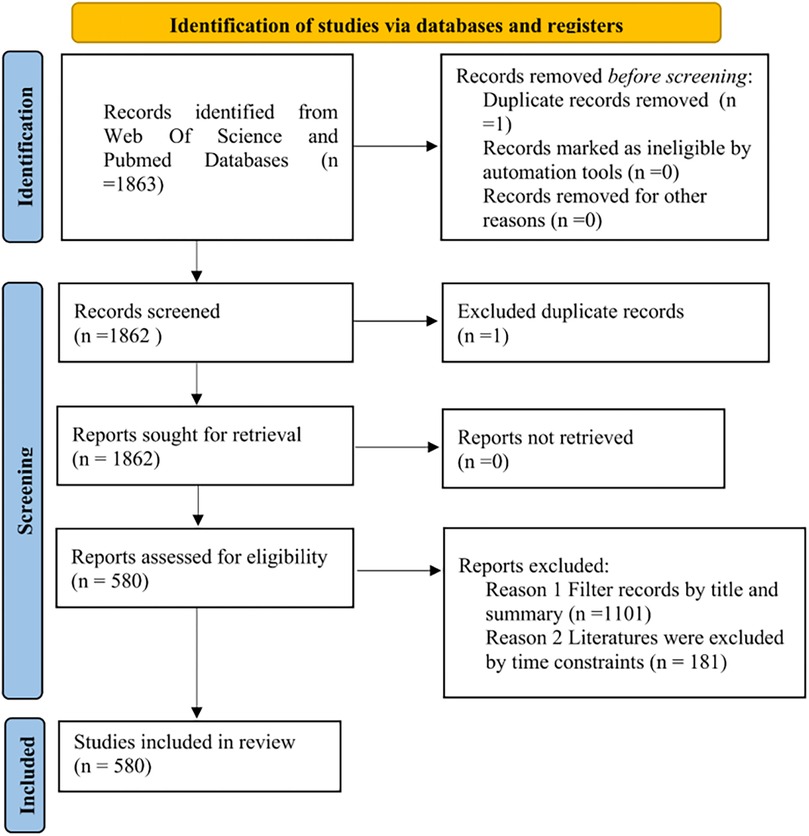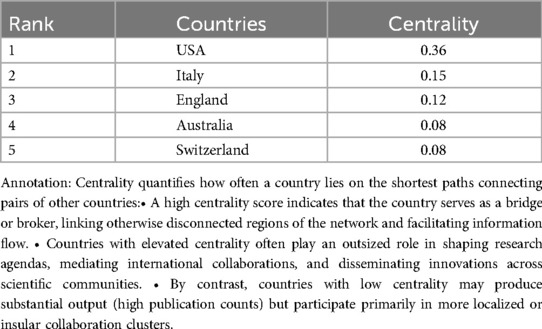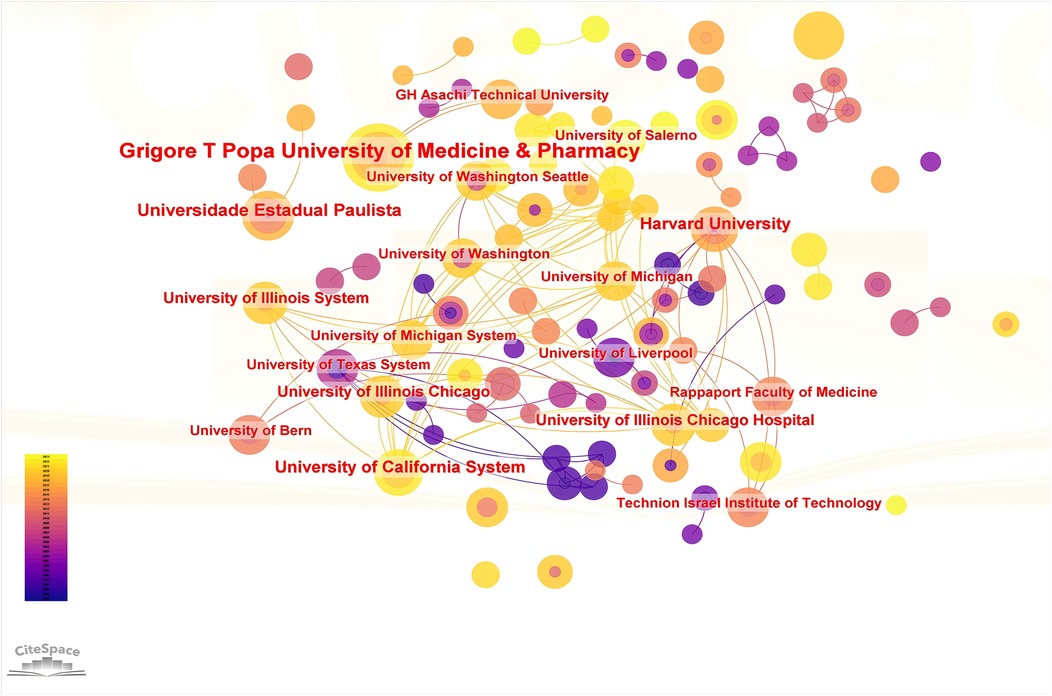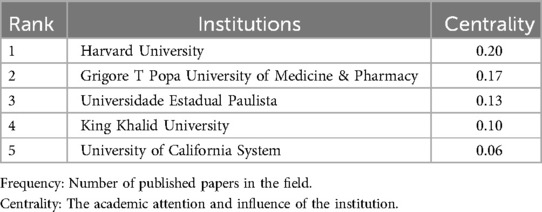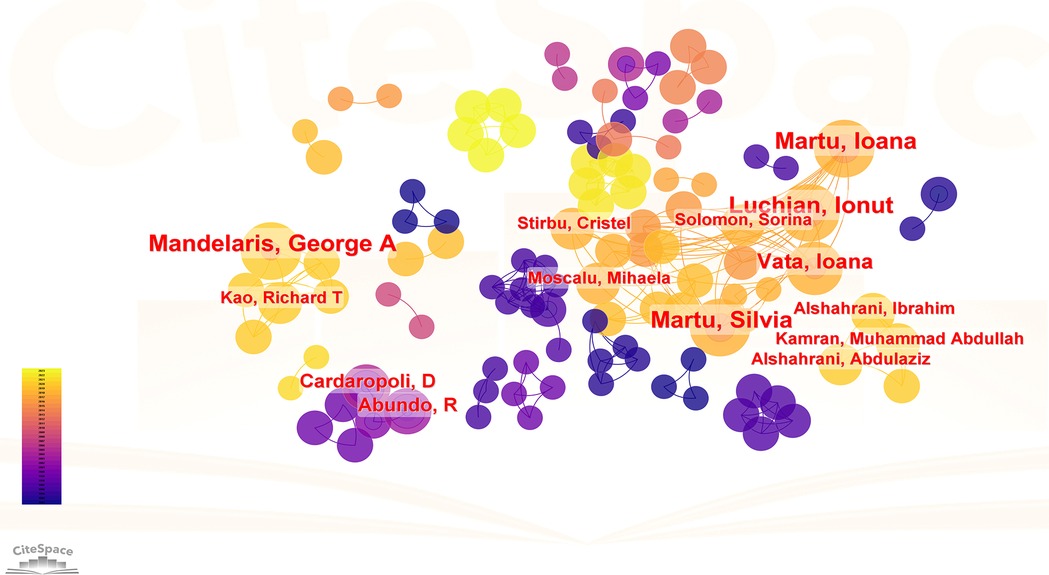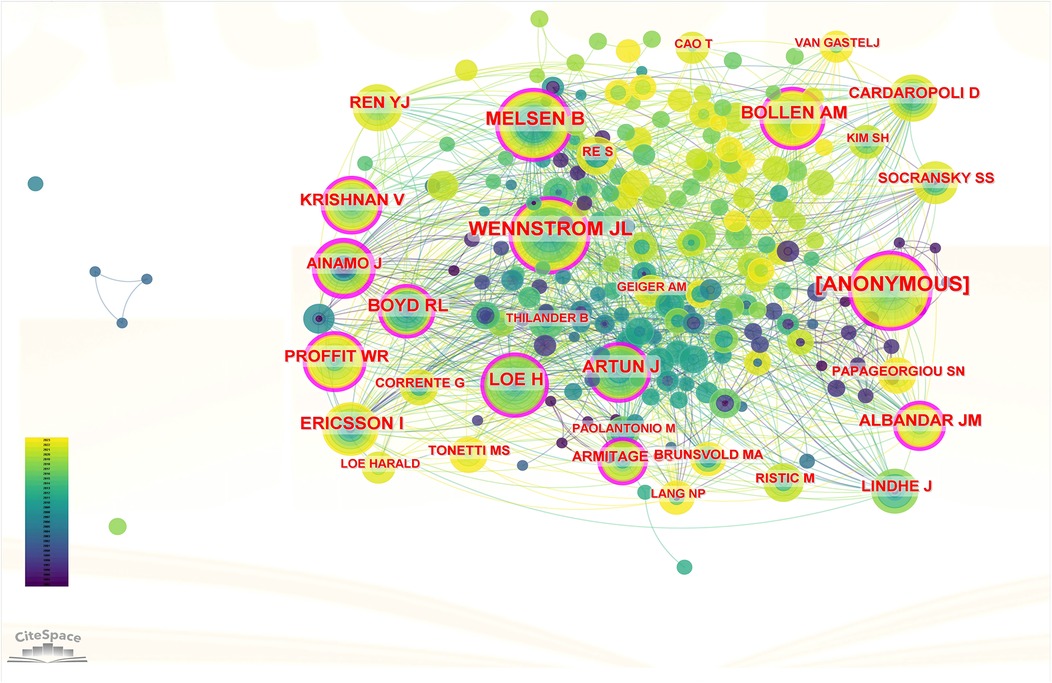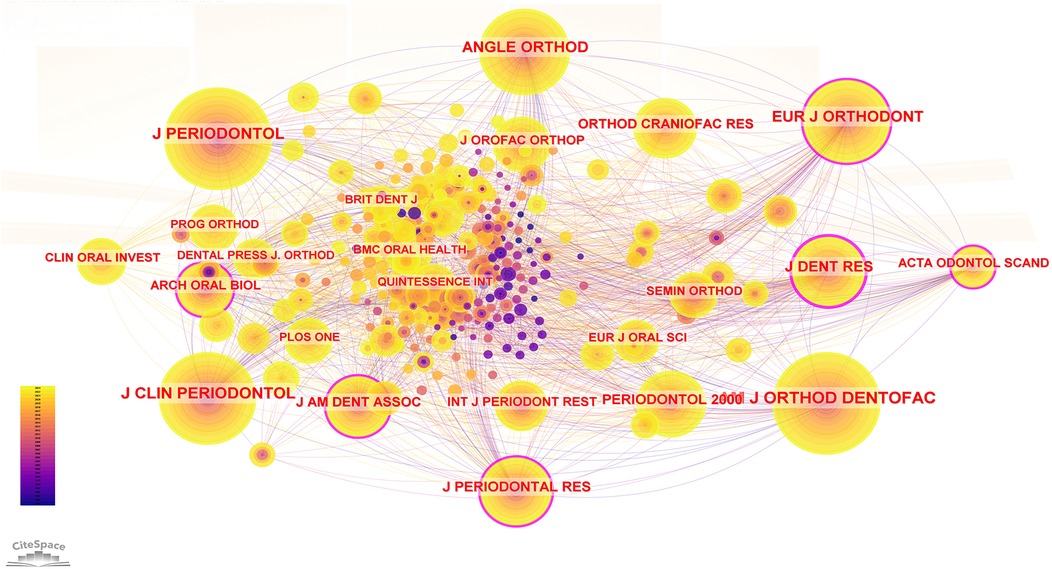- 1Department of Stomatology, Xinzhou People's Hospital, Xinzhou, China
- 2Shanxi Medical University School and Hospital of Stomatology, Taiyuan, China
- 3Department of Orthodontics, Shanxi Provincial People’s Hospital, Shanxi Medical University School and Hospital of Stomatology, Taiyuan, China
Objectives: This study aims to perform a comprehensive bibliometric analysis of research on orthodontic treatment for patients with periodontal disease. By examining publication trends, citation patterns, and research hotspots, we seek to understand the evolution of this field, identify future trends, and promote an integrated approach to enhance treatment outcomes and patient care.
Methods: A comprehensive literature search was performed using the Web of Science and PubMed databases with the keywords “periodontal disease” “periodontology” “periodontitis” and “orthodontics”.The retrieved records were systematically analyzed and visualized utilizing CiteSpace 6.2 and VOSviewer software. Bibliometric analysis was conducted across multiple dimensions, including authorship, geographic distribution (countries and institutions), keyword trends, and citation patterns in relevant journals.
Results: After screening titles, abstracts, and keywords, a total of 580 articles met the inclusion criteria for further analysis. The leading publishing countries were China and USA with significant contributions from Grigore T. Popa University of Medicine & Pharmacy. Ionuț Luchian emerged as the most prolific author, while Ainamo J. demonstrated considerable influence based on citation metrics. Authoritative journals, such as the American Journal of Orthodontics and Dentofacial Orthopedics, were identified as the most frequently cited publications in this field.
Conclusions: Future research in orthodontic treatment for patients with periodontal disease is expected to focus on developing personalized treatment plans, utilizing innovative biomaterials, designing advanced biomarkers and predictive models, integrating regenerative medicine approaches, and comprehensively assessing patients’ overall quality of life. These directions aim to enhance treatment efficacy, improve patient outcomes, and ensure a more holistic and individualized approach to care.
Clinical significance
Our bibliometric findings point to five synergistic domains that can directly inform and enhance clinical management of periodontally compromised patients undergoing orthodontic therapy:
1. Precision-Guided Treatment Planning
a. Incorporate genetic and biomarker screening (e.g., SNP panels, salivary cytokines) into initial assessments to stratify patients by risk of root resorption or periodontal breakdown.
b. Use machine-learning–driven predictive models to tailor force levels, torque prescriptions, and treatment duration-minimizing adverse events in high-risk individuals.
2. Advanced Biomaterials and Digital Workflows
a. Adopt 3D-printed, antimicrobial polymer brackets or shape-memory archwires in patients with active inflammation to reduce plaque retention and improve comfort.
b. Utilize CAD/CAM–generated aligners or custom appliances designed via intraoral scanning and FEA to ensure individualized force application and better control of tooth movement trajectories.
3. Microbiome-Centered Prevention
a. Implement routine monitoring of subgingival microbiota (e.g., 16S rRNA profiling) before and during treatment to detect dysbiosis early.
b. Supplement mechanical debridement with site-specific probiotics or synbiotics to restore microbial balance and blunt inflammatory flares around brackets.
4. Regenerative Support Strategies
a. In cases of existing periodontal defects or delayed movement, coordinate orthodontic activation with local application of MSC-laden scaffolds, PRF membranes, or gene-activated matrices to promote ligament and bone regeneration.
b. Schedule adjunctive growth-factor injections (e.g., rhPDGF-BB) in the most compromised sites to accelerate tissue healing and stabilize periodontium.
5. Holistic, Patient-Centered Care
a. Integrate validated patient-reported outcome measures (OHIP-14, PIDAQ) into routine visits to monitor comfort, anxiety, and satisfaction.
b. Offer pre-treatment virtual-reality simulations or digital counseling apps to reduce dental anxiety, improve adherence, and personalize communication around expected outcomes.
Introduction
Periodontal disease, encompassing conditions such as gingivitis and periodontitis, represents a significant public health concern worldwide due to its high prevalence and potential to cause tooth loss, impaired mastication, and diminished quality of life (1–3). Chronic inflammation of the supporting structures of the teeth not only affects oral health but has also been linked to systemic conditions including cardiovascular disease, diabetes, and adverse pregnancy outcomes (4–6). Effective management of periodontal disease is therefore crucial, necessitating comprehensive approaches that address both the microbial and host-response aspects of the disease (7–9).
Orthodontic treatment, traditionally focused on the alignment of teeth and correction of malocclusions, has increasingly been recognized for its role in optimizing periodontal health (10–13). Properly aligned dentition can enhance plaque control, reduce areas susceptible to periodontal breakdown, and distribute occlusal forces more evenly, thereby mitigating the progression of periodontal disease (14, 15). Conversely, periodontal status can influence orthodontic outcomes, as severe periodontal disease may limit the feasibility and timing of orthodontic interventions (16). This bidirectional relationship underscores the necessity for integrated treatment planning that considers both orthodontic and periodontal perspectives.
Moreover, in periodontal patients undergoing orthodontic therapy, the re-establishment of optimal occlusal relationships and improved dental alignment can have a significant impact on temporomandibular joint (TMJ) health. By harmonizing occlusal contacts and promoting even force distribution across the dental arches, orthodontic interventions may alleviate parafunctional loading and reduce TMJ strain—potentially mitigating symptoms such as joint pain, clicking, or limited range of motion. Conversely, inadequate control of tooth movement in a compromised periodontal foundation can exacerbate joint loading imbalances and provoke or perpetuate temporomandibular disorders. Thus, integrated treatment planning that concurrently addresses periodontal status, occlusion, and TMJ mechanics is essential to optimize both periodontal and temporomandibular outcomes.
Despite broad acknowledgment of the interplay between orthodontic and periodontal therapies, studies in this multidisciplinary field remain fragmented—exhibiting disparate emphases, methodologies, and geographic distributions. Understanding the evolution, current trends, and future directions of research at this intersection is essential for identifying knowledge gaps, fostering collaborations, and guiding evidence-based clinical practices. Bibliometric analysis serves as a powerful tool to quantitatively evaluate the existing literature, revealing patterns in publication output, influential authors and institutions, prevalent research themes, and citation networks (17–24).
Notably, unlike narrative or systematic reviews that depend on subjective selection criteria and yield primarily qualitative syntheses, a bibliometric approach provides a rigorous, data-driven map of the scientific terrain. By analyzing co-authorship and co-citation networks, tracking keyword co-occurrence and burst phenomena, and visualizing institutional and geographic collaborations, bibliometric methods expose the underlying structure and dynamic evolution of a research field. This quantitative perspective uncovers emerging hotspots, reveals interdisciplinary linkages, and highlights underexplored domains—insights that traditional literature reviews alone cannot deliver.
To date, limited bibliometric studies have comprehensively mapped the research on orthodontic treatment in patients with periodontal disease, thereby impeding the ability to synthesize knowledge and identify emerging areas of interest. This study aims to fill this gap by conducting a bibliometric analysis of publications indexed in the Web of Science and PubMed databases. Utilizing advanced visualization tools such as CiteSpace and VOSviewer, we analyze trends in authorship, geographic distribution, keyword prevalence, and citation patterns. By elucidating the intellectual structure and dynamic developments within this field, this research seeks to inform future investigations, enhance interdisciplinary collaboration, and ultimately improve clinical outcomes for patients requiring combined orthodontic and periodontal care.
Materials and methods
Database
Web of Science (WOS) and PubMed are crucial databases in bibliometric analysis, each offering unique strengths. WOS is renowned for its comprehensive coverage across hard sciences, social sciences, and arts, providing robust citation data and high-quality, peer-reviewed sources (23). PubMed excels in the biomedical field, offering free access to a vast repository of life sciences and medical literature, ensuring up-to-date and reliable information. Together, these databases provide a well-rounded, multidisciplinary foundation for thorough and reliable bibliometric studies.
Search strategy
A systematic literature search was conducted on February 10, 2025, utilizing the Web of Science and PubMed databases. The search strategy employed a combination of key terms including “periodontal disease,” “periodontology,” “periodontitis,” and “orthodontics” to identify relevant original research and review articles. No publication date restrictions were imposed to ensure comprehensive inclusion of all eligible documents available through the search date. It is important to note that publications from 2025 reflect partial-year coverage (January to February) and therefore were excluded from longitudinal trend analyses to avoid overinterpretation of annual research patterns.
Data screening and collection
To ensure the quality and reliability of the literature, we systematically searched the Web of Science (WOS) and PubMed databases, applying filters to exclude non-peer-reviewed publications. Three independent researchers conducted a rigorous screening process: initially evaluating titles, keywords, and abstracts, followed by a thorough full-text review to identify the most relevant studies for inclusion. All selected articles, including complete bibliographic information and reference lists, were downloaded in plain text format for subsequent analysis. For comprehensive bibliometric analysis, we employed two specialized software tools: Citespace and VOSviewer. These enabled us to perform detailed network analyses, including co-occurrence and co-citation mapping. Our analysis encompassed annual publication trends, contributing countries and institutions, author contributions, keywords, and journals within the field.
Limitations
Several methodological constraints may affect the breadth and balance of our analysis. First, we restricted retrieval to the Web of Science Core Collection and PubMed, which—while comprehensive—do not cover all relevant outlets. Key articles indexed exclusively in Scopus, Embase, CNKI, Dentistry & Oral Sciences Source, or other specialty repositories may have been omitted, potentially under-representing certain regions or disciplines. Second, by limiting our search to English-language records, we likely excluded high-quality studies published in other languages (e.g., Chinese, Spanish, Portuguese), introducing language bias and skewing geographic and institutional trends. Third, bibliometric outcomes hinge on search-term selection and Boolean operators; although our query was iteratively refined to include major MeSH terms and synonyms for “periodontal disease” and “orthodontics,” alternative descriptors or emerging keywords may fall outside our scope. These limitations could lead to underestimation of publication counts in specific subfields and regions. Future updates should broaden database coverage, incorporate non-English search terms, and include gray-literature sources to achieve a more inclusive, representative mapping of the orthodontic–periodontal research landscape.
Statistical analysis
The core of this study focused on the utilization of numerical values and corresponding percentages to depict the statistical indicators. Importantly, no comparative analyses were conducted, thus eliminating the need for establishing a significance level.
Results
General information
In total, 762 articles were included in our analysis, comprising 695 original research papers and 67 review articles. Given that the software analysis was configured for the period from 2000 to 2025, we ultimately focused on 580 articles for detailed examination (refer to Figure 1). The annual publication rate in this domain was relatively low prior to 2010. However, beginning in 2010, a linear regression analysis of publication counts (2010–2022) revealed a statistically significant upward trend, indicating a steady increase that culminated in a peak in 2022 (refer to Figure 2).
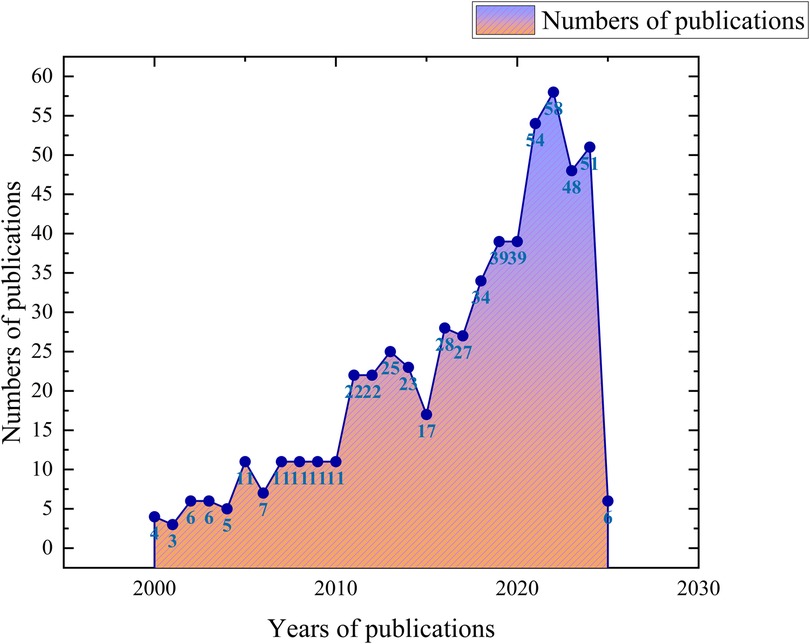
Figure 2. Annual changes in the number of articles published. Annotation: 1. In bibliometric analysis, a node with a high school centrality score means that it plays an important role in connection and communication in the research field, which may be the core research or the research with greater influence in the field. 2. In the various types of co-occurrence plots presented, the color of the nodes has no impact on the analysis outcomes. The size of the nodes, however, serves as a visual indicator of the prominence or engagement with specific literature or research topics over designated time periods. Each node represents a particular time frame, with its size generally correlating to the number of citations or identified relationships during that span. Consequently, larger nodes signify that a node—be it a country, institution, author, keyword, or article—has received substantial citation or discussion, reflecting its influence and significance within the academic community.
Country analysis
We used Citespace 6.2 software to analyze the countries of the target literature. The visualization graph displays 61 nodes and 69 links (see Figure 3), indicating that the relevant literature originates from 61 countries, with 69 instances of co-authorship between any two countries. Statistical analysis identified China, the USA, Germany, Brazil, and Italy as the top five countries in terms of publication output (see Table 1). The centrality score highlights countries' ability to collaborate internationally and their influence in the field. The USA, Italy, England, Australia, and Switzerland ranked highest in centrality scores, with the USA leading, demonstrating its significant collaborative capacity (see Table 2).

Table 1. The top five countries in terms of the number of published papers on periodontal and orthodontic research.
Institution analysis
CiteSpace 6.2 software was used to analyse institution, the visualization graph consists of 160 nodes, with 122 connecting lines between them (see Figure 4). Notably, the target literature in our study was sourced from a diverse range of 160 institutions, and we observed instances where any two institutions appeared together in the same literature for a total of 122 occurrences. The top 5 institutions in terms of the number of publications were Grigore T Popa University of Medicine & Pharmacy, Universidade Estadual Paulista, Harvard University, King Khalid University and University of California System (see Table 3). In the institutional centrality score, Harvard University has the highest centrality score, which demonstrates its academic focus and influence in the field. (see Table 4).
Author and cited author analysis
In CiteSpace, author analysis identifies key contributors, collaboration networks, and research trends within a field, highlighting influential researchers. Cited author analysis, on the other hand, evaluates the impact and recognition of individuals by examining citation frequencies, unveiling foundational works and thought leaders who shape the discipline. Both analyses provide insights into academic influence and collaborative dynamics. The visualization graph consists of 160 nodes, with 122 connecting lines between them. Notably, the target literature in our study was sourced from a diverse range of 160 authors, and we observed instances where any two authors appeared together in the same literature for a total of 122 occurrences (see Figure 5). The top 5 authors in terms of the number of published papers were Luchian Ionut, Martu Silvia, Martu Ioana, Mandelaris George A and Vata Ioana (see Table 5). As depicted in Figure 5, these authors primarily conducted independent research within their respective institutions or countries. Next, we performed author co-citation analysis. Notably, the top 5 co-cited authors comprised [ANONYMOUS], WENNSTROM JL, MELSEN B, ARTUN J and BOLLEN AM (see Table 6). Among the cited authors, the top five authors with centrality scores were AINAMO J, LOE H, MELSEN B, ARTUN J, and BOLLEN AM (see Table 7). AINAMO J has the highest score, which indicates that he has not only extensive cooperation but also great influence in this field (see Figure 6).

Table 7. The most academically influential cited author in the field (centrality: the author's influence in the academic field).
Keyword analysis
In CiteSpace, keyword analysis serves crucial functions by identifying research hotspots and emerging trends within a field. By evaluating keyword occurrences and co-occurrences, researchers can detect central themes and influential studies, shedding light on the intellectual structure and dynamic evolution of the literature. Keyword analysis also helps uncover interdisciplinary links and potential collaboration opportunities across different research domains. Moreover, it informs future research directions by highlighting underexplored areas and guiding researchers toward novel and impactful investigations.
Research hotspot and future trend analysis
According to the analysis (see Figure 7), the current research hotspots in this field focus on the following directions:
1. Personalized treatment plan: Develop a personalized orthodontic treatment plan based on the patient's genetic background, periodontal status, and biomarkers to improve treatment outcomes and reduce complications.
2. Biomaterials and technological innovation: Explore new biocompatible materials and advanced orthodontic technologies, such as 3D printing and digital orthodontics, to improve the accuracy and comfort of treatment.
3. Microbiome and Immune response research: In-depth study of oral microbiota changes and their impact on immune response in periodontal disease patients during orthodontic treatment to develop more effective prevention strategies.
4. Biomarkers and predictive models: The use of biomarkers and machine learning technology to establish predictive models to assess the risk and prognosis of orthodontic treatment for patients with periodontal disease, and improve the scientific nature of clinical decision-making.
5. Regenerative Medicine and Tissue engineering: Research periodontal tissue regeneration techniques, such as stem cell therapy and growth factor application, to promote periodontal tissue repair and improve the success rate of orthodontic treatment.
6. Patients’ quality of life and psychological factors: To evaluate the impact of orthodontic treatment on periodontal disease patients’ quality of life and psychological state, and develop a more humane treatment plan.
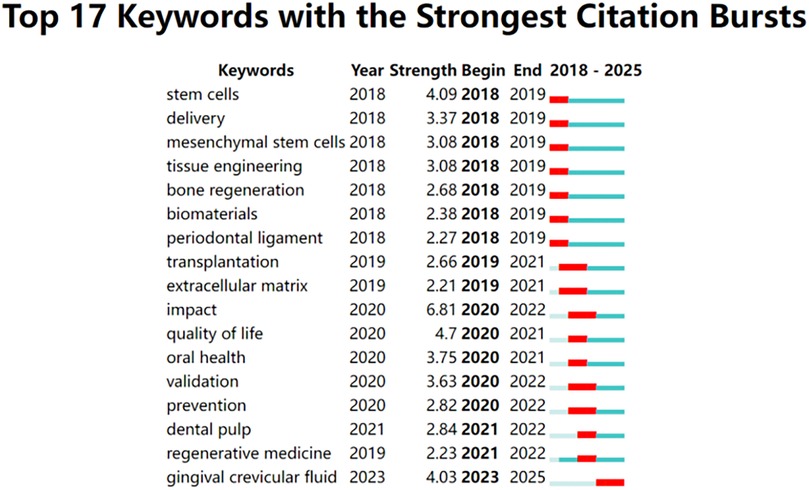
Figure 7. Burst graph of keywords. Note to Figure: Among the multitude of keywords examined, a notable selection of 11 emerged distinguished by their significant citation bursts. These keywords exhibited pronounced peaks denoted by red lines, symbolizing the years when they were prominently employed. Conversely, green lines signify periods within the timeframe from 1993 to 2023 when these keywords were less frequently utilized.
Advances in orthodontic treatment identified through keyword analysis
Building on our keyword-driven analysis, recent innovations are converging to offer safer, more effective orthodontic care for patients with existing periodontal disease:
1. Precision Force Control via Smart Appliances
• Sensor-Integrated Brackets and Aligners: Miniaturized force sensors embedded in brackets or clear aligners feed real-time data into AI-driven controllers, enabling micro-adjustments of orthodontic forces to stay within safe thresholds for compromised bone and ligament tissue.
• Closed-Loop Biomechanical Simulation: Digital-twin models of each patient's dento-periodontal complex, built from CBCT scans and periodontal probing data, allow virtual trialing of force vectors before clinical activation—minimizing iatrogenic attachment loss.
2. 3D-Printed, Biofunctionalized Biomaterials
• Antimicrobial & Anti-Inflammatory Surface Coatings: Customized, 3D-printed brackets and auxiliaries are now being coated with slow-release agents (e.g., silver nanoparticles, chlorhexidine) or pro-resolving lipid mediators to suppress biofilm overgrowth and local cytokine surges.
• Bioresorbable Polymer Appliances: Shape-memory polymers that gradually degrade over the course of treatment reduce the need for appliance removal and decrease plaque-retentive hardware in the gingival sulcus.
3. Integrated Regenerative Therapies
• Gene-Activated Scaffolds: Orthodontic anchorage devices and membrane systems are being loaded with osteogenic microRNAs or BMP-2 plasmids to promote alveolar bone remodeling in situ, enhancing both tooth movement and periodontal regeneration.
• Stem Cell–Enriched Gels: Injectable, photo-crosslinkable nanogels carrying mesenchymal stem cells (MSCs) or platelet-rich fibrin have been applied alongside tooth-movement sites to accelerate ligament repair and reduce post-force inflammation.
4. Microbiome-Targeted Adjuncts
• Probiotic/Synbiotic Delivery Systems: Aligners and power chains are being engineered to release tailored probiotic strains directly into the sulcus, stabilizing beneficial microbial communities and preventing dysbiotic shifts during orthodontic therapy.
• Organoid and “Gum-on-a-Chip” Screening: Microfluidic periodontal models guide rapid testing of novel anti-inflammatory and antimicrobial agents under simulated orthodontic force, speeding translation of new adjuncts into clinical trials.
5. Digital Monitoring & Patient Engagement
• Remote Periodontal Health Dashboards: Smartphone apps linked to intraoral cameras and wearable gingival sensors allow continuous monitoring of probing depths, bleeding on probing, and patient-reported discomfort—triggering alerts for both clinician and patient if inflammatory markers rise.
• Virtual-Reality Pre-Treatment Counseling: VR simulations of anticipated tooth movement and gingival response reduce patient anxiety and improve adherence to oral-hygiene protocols throughout treatment.
Cited journal analysis
The co-citation of journals reflects the correlation between various journals and disciplines. We can gain many benefits from cited journal. On the one hand, through the analysis of cited journals, we can learn about the authoritative journals in our research field to obtain more professional and credible information. On the other hand, this can help us to find the direction of submission and help us to find the most suitable journals for our research direction. In the cited journal visualization analysis plot, we can see that there are 259 nodes and 1,812 lines connecting any two nodes. This indicates that our selected literature cited 259 different journals, and the number of times any two cited journals appeared in the same literature reached 1,812 times (see Figure 8). The top five most frequently cited journals were AM J ORTHOD DENTOFAC, J PERIODONTOL, J CLIN PERIODONTOL, ANGLE ORTHOD and EUR J ORTHODONT (see Table 8). These journals are among the most authoritative in the field of orthodontics and periodontics. The top five journals with the highest centrality scores were J DENT RES, J PERIODONTAL RES, EUR J ORTHODONT, ACTA ODONTOL SCAND and ARCH ORAL BIOL (see Table 8). The centrality score of cited journals can help us to choose the most needed professional information and the best direction for submission.
Discussion
This bibliometric analysis provides a comprehensive overview of the research landscape surrounding orthodontic treatment for patients with periodontal disease. By examining publication trends, influential authors and institutions, and prevailing research themes, the study elucidates the evolution and current state of this multidisciplinary field, while also highlighting future directions for research and clinical practice (25).
Key findings and interpretation
Our analysis revealed a notable increase in publications on orthodontic treatment in the context of periodontal disease starting around 2010, with a peak in 2022. This surge likely reflects the growing recognition of the intricate relationship between orthodontic treatment and periodontal health, as well as advancements in technologies and methodologies that facilitate integrated treatment approaches. China, the USA, and Germany emerged as the leading contributors, underscoring the global interest and investment in this area. Institutions such as Grigore T. Popa University of Medicine & Pharmacy and Harvard University demonstrated significant output and influence, indicating their pivotal roles in advancing research and clinical practices.
The identification of key authors, notably Ionuț Luchian and Ainamo J., highlights the contributions of individual researchers in shaping the field. Ainamo J.'s high centrality score suggests a foundational influence, potentially through seminal works that have guided subsequent research and clinical protocols.
Research hotspots and emerging trends
The keyword analysis pinpointed several critical areas of focus that reflect both current challenges and innovative solutions in the field:
1. Personalized Treatment Planning & Predictive Modeling: Emphasis on tailoring orthodontic interventions based on genetic, periodontal, and biomarker profiles signifies a shift towards precision medicine. This approach aims to enhance treatment efficacy and minimize complications by accounting for individual patient variations (26–29) The integration of biomarkers and machine learning to create predictive models represents a significant advancement in assessing treatment risks and prognoses. These tools enhance clinical decision-making by providing evidence-based predictions tailored to individual patient profiles (30–34).
• Rationale: Standardized orthodontic protocols often fail to account for inter-individual variability in bone metabolism, inflammatory profile, and genetic susceptibility.
• Advances: Over the past three years, keywords such as “genetic polymorphism,” “salivary biomarkers,” and “machine learning” have shown strong citation bursts. Researchers have combined single-nucleotide polymorphism (SNP) panels with serum cytokine levels to build risk-scoring models for root resorption and periodontal breakdown (35–37).
• Emerging subthemes:
Integration of multi-omics data (genomics, proteomics, metabolomics) in predictive algorithms.
Real-time adjustment of force application based on patient-specific biomechanical simulations.
2. Biomaterials Innovation & Digital Orthodontics: The exploration of new biocompatible materials and advanced technologies such as 3D printing and digital orthodontics highlights the ongoing efforts to improve the precision, comfort, and outcomes of orthodontic treatments. These innovations not only enhance clinical practice but also contribute to patient satisfaction and compliance (38–47).
• Rationale: Patient comfort, treatment precision, and cross-infection control drive the search for next-generation appliances.
• Advances: The clusters “3D-printing” and “CAD/CAM” have expanded sharply since 2019. Biodegradable polymer brackets, shape-memory alloys, and antimicrobial surface coatings are under intensive investigation (48, 49). In parallel, intraoral scanners and finite-element analysis (FEA) software enable clinicians to visualize tooth-movement trajectories before applying forces (50).
• Emerging subthemes:
Smart brackets with embedded sensors for real-time force measurement.
AI-powered treatment-simulation platforms that predict both aesthetic outcome and periodontal health impact.
3. Oral Microbiome, Immune Response & Prevention Strategies: Understanding the dynamics of oral microbiota and their interactions with the immune system during orthodontic treatment is crucial for developing effective prevention and management strategies for periodontal complications. This research underscores the importance of maintaining a healthy oral environment to support both periodontal and orthodontic health (51–60).
• Rationale: Orthodontic appliances can disrupt biofilm ecology, altering local immune signaling and predisposing to periodontal breakdown.
• Advances: Keywords “oral microbiota,” “inflammation markers,” and “cytokine profile” co-occur in a distinct cluster that peaked in 2021–2022. Longitudinal 16S rRNA and metagenomic studies have mapped shifts in subgingival communities during fixed-appliance therapy, linking certain pathogen surges (e.g., Porphyromonas gingivalis) to IL-1β elevation and alveolar bone loss (61, 62).
• Emerging subthemes:
Probiotic or synbiotic adjuncts to modulate dysbiosis.
Microfluidic “gum-on-a-chip” models to screen anti-inflammatory biomaterials.
4. Regenerative Medicine & Tissue Engineering: Investigations into stem cell therapy and growth factor applications for periodontal tissue regeneration reflect the potential to not only halt disease progression but also restore damaged periodontal structures. These regenerative approaches could significantly improve the long-term success rates of orthodontic treatments in periodontally compromised patients (63–67).
• Rationale: Iatrogenic periodontal defects and delayed tooth movement can both benefit from targeted tissue-engineering approaches.
• Advances: The “stem cells,” “growth factors,” and “3D scaffold” clusters highlight a surge in preclinical studies using mesenchymal stem cells (MSCs), platelet-rich fibrin (PRF), and bioactive glass composites to accelerate ligament regeneration (68, 69).
• Emerging subthemes:
Gene-activated matrices that locally deliver osteogenic miRNAs.
Bioprinting of periodontal ligament–cementum complex for in vivo transplantation.
5. Patient-Centered Outcomes & Psychosocial Dimensions: Assessing the impact of orthodontic treatment on patients’ quality of life and psychological well-being emphasizes a holistic approach to care. Understanding these factors is essential for developing humane treatment plans that address both physical and emotional aspects of patient health (26, 70–75).
• Rationale: Clinician-reported measures (e.g., probing depth, tooth movement distance) overlook the patient's perceived comfort, aesthetics, and quality of life.
• Advances: Since 2020, “oral-health-related quality of life,” “anxiety,” and “treatment satisfaction” have formed a cohesive cluster. Mixed-methods trials are now routinely incorporating validated PROM instruments (OHIP-14, PIDAQ) and semi-structured interviews to gauge adherence drivers and psychological stress (76, 77).
While all identified domains represent substantive research frontiers, their translational timelines and potential impacts warrant differentiated consideration. Based on current technological readiness and clinical demand, two areas emerge as particularly actionable:Biomaterials Innovation & Digital Orthodontics and Personalized Treatment Planning. The oral microbiome modulation and regenerative approaches, though scientifically transformative, currently face longer translational pathways due to regulatory complexities in live-biologic applications. Nevertheless, probiotic adjuvants and gene-activated scaffolds merit prioritized funding as mid-term (5–7 year) solutions for refractory periodontitis cases. Patient-centered outcome tools, while methodologically mature, require paradigm shifts in clinical evaluation standards to achieve systemic impact.
• Emerging subthemes:
Virtual-reality tools for pre-treatment counseling to reduce dental anxiety.
Longitudinal assessment of digital-app–based support networks on treatment compliance.
Future directions
Looking forward, these five fronts are converging into a holistic, precision-digital-bio-behavioral paradigm. We anticipate:
• Closed-loop systems that marry intraoral sensor feedback with adaptive force modulation.
• Integrated dashboards combining genomic risk scores, microbiome profiles, and real-time patient-reported outcomes.
• Cross-disciplinary consortia leveraging big-data analytics to refine evidence-based guidelines.The trends and hotspots identified in this analysis are consistent with broader movements in dental research towards precision medicine, technological integration, and holistic patient care. Previous studies have also highlighted the bidirectional relationship between orthodontics and periodontology, emphasizing the need for integrated treatment planning. However, this bibliometric approach provides a more nuanced and quantitative assessment of the field, offering insights that complement qualitative reviews and clinical studies. While this study provides valuable insights, it is subject to certain limitations. The reliance on Web of Science and PubMed databases may exclude relevant studies indexed elsewhere, potentially affecting the comprehensiveness of the analysis. Additionally, bibliometric indicators such as publication and citation counts do not fully capture the quality or clinical impact of individual studies. Future research could incorporate additional databases and qualitative assessments to provide a more exhaustive understanding of the field.
Data availability statement
The raw data supporting the conclusions of this article will be made available by the authors, without undue reservation.
Author contributions
JZ: Formal analysis, Visualization, Writing – review & editing. ZeF: Conceptualization, Data curation, Formal analysis, Funding acquisition, Investigation, Methodology, Project administration, Resources, Software, Visualization, Writing – original draft, Writing – review & editing. YL: Investigation, Methodology, Writing – original draft. SS: Conceptualization, Data curation, Writing – original draft. ZhF: Methodology, Project administration, Writing – review & editing.
Funding
The author(s) declare that financial support was received for the research and/or publication of this article. This research was funded by the Science and Technology Department of Shanxi Province, and the funding name was “Preparation of Laser-Induced Thermoreactive Nanoparticles Loaded with Ag/CuO” and “Research on Their Antibacterial Properties” (Project Number: 202103021224371).
Conflict of interest
The authors declare that the research was conducted in the absence of any commercial or financial relationships that could be construed as a potential conflict of interest.
Generative AI statement
The author(s) declare that no Generative AI was used in the creation of this manuscript.
Publisher's note
All claims expressed in this article are solely those of the authors and do not necessarily represent those of their affiliated organizations, or those of the publisher, the editors and the reviewers. Any product that may be evaluated in this article, or claim that may be made by its manufacturer, is not guaranteed or endorsed by the publisher.
References
1. Hajishengallis G. Interconnection of periodontal disease and comorbidities: evidence, mechanisms, and implications. Periodontol 2000. (2022) 89(1):9–18. doi: 10.1111/prd.12430
2. Kinane DF, Stathopoulou PG, Papapanou PN. Periodontal diseases. Nat Rev Dis Primers. (2017) 3:17038. doi: 10.1038/nrdp.2017.38
3. Shaddox LM, Morford LA, Nibali L. Periodontal health and disease: the contribution of genetics. Periodontol 2000. (2021) 85(1):161–81. doi: 10.1111/prd.12357
4. Liccardo D, Cannavo A, Spagnuolo G, Ferrara N, Cittadini A, Rengo C, et al. Periodontal disease: a risk factor for diabetes and cardiovascular disease. Int J Mol Sci. (2019) 20(6):1414. doi: 10.3390/ijms20061414
5. Graves DT, Ding Z, Yang Y. The impact of diabetes on periodontal diseases. Periodontol 2000. (2020) 82(1):214–24. doi: 10.1111/prd.12318
6. Bobetsis YA, Graziani F, Gürsoy M, Madianos PN. Periodontal disease and adverse pregnancy outcomes. Periodontol 2000. (2020) 83(1):154–74. doi: 10.1111/prd.12294
7. Mombelli A. Microbial colonization of the periodontal pocket and its significance for periodontal therapy. Periodontol 2000. (2018) 76(1):85–96. doi: 10.1111/prd.12147
8. Sälzer S, Graetz C, Dörfer CE, Slot DE, Van der Weijden FA. Contemporary practices for mechanical oral hygiene to prevent periodontal disease. Periodontol 2000. (2020) 84(1):35–44. doi: 10.1111/prd.12332
9. Slots J, Jorgensen MG. Effective, safe, practical and affordable periodontal antimicrobial therapy: where are we going, and are we there yet? Periodontol 2000. (2002) 28:298–312. doi: 10.1034/j.1600-0757.2002.2801123.x
10. Krishnan V, Davidovitch Z. On a path to unfolding the biological mechanisms of orthodontic tooth movement. J Dent Res. (2009) 88(7):597–608. doi: 10.1177/0022034509338914
11. Verna C, Dalstra M, Lee TC, Cattaneo PM, Melsen B. Microcracks in the alveolar bone following orthodontic tooth movement: a morphological and morphometric study. Eur J Orthod. (2004) 26(5):459–67. doi: 10.1093/ejo/26.5.459
12. Westover L, Faulkner G, Flores-Mir C, Hodgetts W, Raboud D. Non-invasive evaluation of periodontal ligament stiffness during orthodontic tooth movement. Angle Orthod. (2019) 89(2):228–34. doi: 10.2319/031918-218.1
13. Matsumoto T, Iimura T, Ogura K, Moriyama K, Yamaguchi A. The role of osteocytes in bone resorption during orthodontic tooth movement. J Dent Res. (2013) 92(4):340–5. doi: 10.1177/0022034513476037
14. Han SH, Ko Y, Ham LK, Park JH, Kim Y. Precautions and possibilities in orthodontic treatment of periodontally compromised patients: current recommendations. J Esthet Restor Dent. (2024) 36(4):595–605. doi: 10.1111/jerd.13166
15. Ostreicher DS. Orthodontic treatment and periodontal health. Journal of the American Dental Association (1939). (2008) 139(7):887–8. author reply 9-90. doi: 10.14219/jada.archive.2008.0265
16. Ryder MI, Armitage GC. Minimally invasive periodontal therapy for general practitioners. Periodontol 2000. (2016) 71(1):7–9. doi: 10.1111/prd.12132
17. Carve M, Allinson G, Nugegoda D, Shimeta J. Trends in environmental and toxicity research on organic ultraviolet filters: a scientometric review. Sci Total Environ. (2021) 773:145628. doi: 10.1016/j.scitotenv.2021.145628
18. Chen C. Citespace II: detecting and visualizing emerging trends and transient patterns in scientific literature. J Am Soc Inf Sci Technol. (2006) 57(3):359–77. doi: 10.1002/asi.20317
19. Chen C, Hu Z, Liu S, Tseng H. Emerging trends in regenerative medicine: a scientometric analysis in CiteSpace. Expert Opin Biol Ther. (2012) 12(5):593–608. doi: 10.1517/14712598.2012.674507
20. He T, Wu Z, Zhang X, Liu H, Wang Y, Jiang R, et al. A bibliometric analysis of research on the role of BDNF in depression and treatment. Biomolecules. (2022) 12(10):1464. doi: 10.3390/biom12101464
21. Li D, Yu D, Li Y, Yang R. A bibliometric analysis of PROTAC from 2001 to 2021. Eur J Med Chem. (2022) 244:114838. doi: 10.1016/j.ejmech.2022.114838
22. Liu S, Sun YP, Gao XL, Sui Y. Knowledge domain and emerging trends in Alzheimer’s disease: a scientometric review based on CiteSpace analysis. Neural Regen Res. (2019) 14(9):1643–50. doi: 10.4103/1673-5374.255995
23. Liu X, Zhao S, Tan L, Tan Y, Wang Y, Ye Z, et al. Frontier and hot topics in electrochemiluminescence sensing technology based on CiteSpace bibliometric analysis. Biosens Bioelectron. (2022) 201:113932. doi: 10.1016/j.bios.2021.113932
24. Yao L, Hui L, Yang Z, Chen X, Xiao A. Freshwater microplastics pollution: detecting and visualizing emerging trends based on citespace II. Chemosphere. (2020) 245:125627. doi: 10.1016/j.chemosphere.2019.125627
25. Merigó JM, G-L AM, Yager RR. An overview of fuzzy research with bibliometric indicators. Appl Soft Comput. (2015) 27:420–33. doi: 10.1016/j.asoc.2014.10.035
26. Chapple IL, Bouchard P, Cagetti MG, Campus G, Carra MC, Cocco F, et al. Interaction of lifestyle, behaviour or systemic diseases with dental caries and periodontal diseases: consensus report of group 2 of the joint EFP/ORCA workshop on the boundaries between caries and periodontal diseases. J Clin Periodontol. (2017) 44(Suppl 18):S39–s51. doi: 10.1111/jcpe.12685
27. Loos BG, Van Dyke TE. The role of inflammation and genetics in periodontal disease. Periodontol 2000. (2020) 83(1):26–39. doi: 10.1111/prd.12297
28. Beydoun MA, Beydoun HA, Hu YH, Li Z, Georgescu MF, Noren Hooten N, et al. Mediating and moderating effects of plasma proteomic biomarkers on the association between poor oral health problems and brain white matter microstructural integrity: the UK biobank study. Mol Psychiatry. (2025) 30(2):388–401. doi: 10.1038/s41380-024-02678-3
29. He W, You M, Wan W, Xu F, Li F, Li A. Point-of-care periodontitis testing: biomarkers, current technologies, and perspectives. Trends Biotechnol. (2018) 36(11):1127–44. doi: 10.1016/j.tibtech.2018.05.013
30. Bashir NZ, Rahman Z, Chen SL. Systematic comparison of machine learning algorithms to develop and validate predictive models for periodontitis. J Clin Periodontol. (2022) 49(10):958–69. doi: 10.1111/jcpe.13692
31. Beak W, Park J, Ji S. Data-driven prediction model for periodontal disease based on correlational feature analysis and clinical validation. Heliyon. (2024) 10(11):e32496. doi: 10.1016/j.heliyon.2024.e32496
32. Boitor O, Stoica F, Mihăilă R, Stoica LF, Stef L. Automated machine learning to develop predictive models of metabolic syndrome in patients with periodontal disease. Diagnostics (Basel). (2023) 13(24):3631. doi: 10.3390/diagnostics13243631
33. Mohammad-Rahimi H, Motamedian SR, Pirayesh Z, Haiat A, Zahedrozegar S, Mahmoudinia E, et al. Deep learning in periodontology and oral implantology: a scoping review. J Periodontal Res. (2022) 57(5):942–51. doi: 10.1111/jre.13037
34. Uzun Saylan BC, Baydar O, Yeşilova E, Kurt Bayrakdar S, Bilgir E, Bayrakdar İŞ, et al. Assessing the effectiveness of artificial intelligence models for detecting alveolar bone loss in periodontal disease: a panoramic radiograph study. Diagnostics (Basel). (2023) 13(10):1800. doi: 10.3390/diagnostics13101800 37238284
35. Kurushima Y, Wells PM, Bowyer RCE, Zoheir N, Doran S, Richardson JP, et al. Host genotype links to salivary and gut Microbiota by periodontal Status. J Dent Res. (2023) 102(2):146–56. doi: 10.1177/00220345221125402
36. Li M, Zhang Y, Zhang A, Cai H, Zhang R, Cheng R, et al. Association between polymorphisms of anti-inflammatory gene alleles and periodontitis risk in a Chinese han population. Clin Oral Investig. (2023) 27(11):6689–700. doi: 10.1007/s00784-023-05278-7
37. Stolf CS, Pereira AGS, Almeida BC, Paz HES, Arroteia LS, Huang H, et al. Association of RS1126478 (LTF) with molar-incisor and generalized periodontitis. Clin Oral Investig. (2024) 28(12):653. doi: 10.1007/s00784-024-06056-9
38. Deng D, Li X, Zhang JJ, Yin Y, Tian Y, Gan D, et al. Biotin-Avidin system-based delivery enhances the therapeutic performance of MSC-derived exosomes. ACS Nano. (2023) 17(9):8530–50. doi: 10.1021/acsnano.3c00839
39. Guo H, Li B, Wu M, Zhao W, He X, Sui B, et al. Odontogenesis-related developmental microenvironment facilitates deciduous dental pulp stem cell aggregates to revitalize an avulsed tooth. Biomaterials. (2021) 279:121223. doi: 10.1016/j.biomaterials.2021.121223
40. He XT, Li X, Zhang M, Tian BM, Sun LJ, Bi CS, et al. Role of molybdenum in material immunomodulation and periodontal wound healing: targeting immunometabolism and mitochondrial function for macrophage modulation. Biomaterials. (2022) 283:121439. doi: 10.1016/j.biomaterials.2022.121439
41. Huang H, Pan W, Wang Y, Kim HS, Shao D, Huang B, et al. Nanoparticulate cell-free DNA scavenger for treating inflammatory bone loss in periodontitis. Nat Commun. (2022) 13(1):5925. doi: 10.1038/s41467-022-33492-6
42. Ni C, Zhou J, Kong N, Bian T, Zhang Y, Huang X, et al. Gold nanoparticles modulate the crosstalk between macrophages and periodontal ligament cells for periodontitis treatment. Biomaterials. (2019) 206:115–32. doi: 10.1016/j.biomaterials.2019.03.039
43. Sun Y, Sun X, Li X, Li W, Li C, Zhou Y, et al. A versatile nanocomposite based on nanoceria for antibacterial enhancement and protection from aPDT-aggravated inflammation via modulation of macrophage polarization. Biomaterials. (2021) 268:120614. doi: 10.1016/j.biomaterials.2020.120614
44. Wu S, Xu J, Zou L, Luo S, Yao R, Zheng B, et al. Long-lasting renewable antibacterial porous polymeric coatings enable titanium biomaterials to prevent and treat peri-implant infection. Nat Commun. (2021) 12(1):3303. doi: 10.1038/s41467-021-23069-0
45. Chen L, Yu H, Li Z, Wang Y, Jin S, Yu M, et al. Force-induced caspase-1-dependent pyroptosis regulates orthodontic tooth movement. Int J Oral Sci. (2024) 16(1):3. doi: 10.1038/s41368-023-00268-7
46. Liu H, Zhang Y, Zhang Y, Huang Y, Yang Y, Zhao Y, et al. Periodontal ligament cell apoptosis activates Lepr+ Osteoprogenitors in orthodontics. J Dent Res. (2024) 103(9):937–47. doi: 10.1177/00220345241262706
47. Martin C, Littlewood SJ, Millett DT, Doubleday B, Bearn D, Worthington HV, et al. Retention procedures for stabilising tooth position after treatment with orthodontic braces. Cochrane Database Syst Rev. (2023) 5(5):Cd002283. doi: 10.1002/14651858.CD002283.pub5
48. Fernandes GLP, Vanim MM, Delbem ACB, Martorano AS, Raucci L, de Oliveira PT, et al. Antibacterial, cytotoxic and mechanical properties of a orthodontic cement with phosphate nano-sized and phosphorylated chitosan: an in vitro study. J Dent. (2024) 146:105073. doi: 10.1016/j.jdent.2024.105073
49. Wang Y, Venezuela J, Dargusch M. Biodegradable shape memory alloys: progress and prospects. Biomaterials. (2021) 279:121215. doi: 10.1016/j.biomaterials.2021.121215
50. Chen Q, Luo S, Wang Y, Chen Z, Li Y, Meng M, et al. Three-dimensional finite element analysis of occlusal stress on maxillary first molars with different marginal morphologies restored with occlusal veneers. BMC Oral Health. (2024) 24(1):1349. doi: 10.1186/s12903-024-05121-9
51. Balta MG, Papathanasiou E, Blix IJ, Van Dyke TE. Host modulation and treatment of periodontal disease. J Dent Res. (2021) 100(8):798–809. doi: 10.1177/0022034521995157
52. Cekici A, Kantarci A, Hasturk H, Van Dyke TE. Inflammatory and immune pathways in the pathogenesis of periodontal disease. Periodontol 2000. (2014) 64(1):57–80. doi: 10.1111/prd.12002
53. López-Valverde N, Quispe-López N, Blanco Rueda JA. Inflammation and immune response in the development of periodontal disease: a narrative review. Front Cell Infect Microbiol. (2024) 14:1493818. doi: 10.3389/fcimb.2024.1493818
54. Sedghi LM, Bacino M, Kapila YL. Periodontal disease: the good, the bad, and the unknown. Front Cell Infect Microbiol. (2021) 11:766944. doi: 10.3389/fcimb.2021.766944
55. Zhou M, Graves DT. Impact of the host response and osteoblast lineage cells on periodontal disease. Front Immunol. (2022) 13:998244. doi: 10.3389/fimmu.2022.998244
56. Di Stefano M, Polizzi A, Santonocito S, Romano A, Lombardi T, Isola G. Impact of oral microbiome in periodontal health and periodontitis: a critical review on prevention and treatment. Int J Mol Sci. (2022) 23(9):5142. doi: 10.3390/ijms23095142
57. Iniesta M, Chamorro C, Ambrosio N, Marín MJ, Sanz M, Herrera D. Subgingival microbiome in periodontal health, gingivitis and different stages of periodontitis. J Clin Periodontol. (2023) 50(7):905–20. doi: 10.1111/jcpe.13793
58. Kuraji R, Shiba T, Dong TS, Numabe Y, Kapila YL. Periodontal treatment and microbiome-targeted therapy in management of periodontitis-related nonalcoholic fatty liver disease with oral and gut dysbiosis. World J Gastroenterol. (2023) 29(6):967–96. doi: 10.3748/wjg.v29.i6.967
59. Sedghi L, DiMassa V, Harrington A, Lynch SV, Kapila YL. The oral microbiome: role of key organisms and complex networks in oral health and disease. Periodontol 2000. (2021) 87(1):107–31. doi: 10.1111/prd.12393
60. Zhang Y, Wang X, Li H, Ni C, Du Z, Yan F. Human oral microbiota and its modulation for oral health. Biomed Pharmacother. (2018) 99:883–93. doi: 10.1016/j.biopha.2018.01.146
61. Cao G, Xu Q, Huang S, Dai D, Wang J, Li W, et al. B10 cells regulate macrophage polarization to alleviate inflammation and bone loss in periodontitis. J Periodontol. (2025) 96(4):355–68. doi: 10.1002/JPER.24-0114
62. Qiao X, Tang J, Dou L, Yang S, Sun Y, Mao H, et al. Dental pulp stem cell-derived exosomes regulate anti-inflammatory and osteogenesis in periodontal ligament stem cells and promote the repair of experimental periodontitis in rats. Int J Nanomed. (2023) 18:4683–703. doi: 10.2147/IJN.S420967
63. Farshidfar N, Jafarpour D, Firoozi P, Sahmeddini S, Hamedani S, de Souza RF, et al. The application of injectable platelet-rich fibrin in regenerative dentistry: a systematic scoping review of in vitro and in vivo studies. Jpn Dent Sci Rev. (2022) 58:89–123. doi: 10.1016/j.jdsr.2022.02.003
64. Jepsen S, Gennai S, Hirschfeld J, Kalemaj Z, Buti J, Graziani F. Regenerative surgical treatment of furcation defects: a systematic review and Bayesian network meta-analysis of randomized clinical trials. J Clin Periodontol. (2020) 47(Suppl 22):352–74. doi: 10.1111/jcpe.13238
65. Miron RJ, Moraschini V, Fujioka-Kobayashi M, Zhang Y, Kawase T, Cosgarea R, et al. Use of platelet-rich fibrin for the treatment of periodontal intrabony defects: a systematic review and meta-analysis. Clin Oral Investig. (2021) 25(5):2461–78. doi: 10.1007/s00784-021-03825-8
66. Stavropoulos A, Bertl K, Spineli LM, Sculean A, Cortellini P, Tonetti M. Medium- and long-term clinical benefits of periodontal regenerative/reconstructive procedures in intrabony defects: systematic review and network meta-analysis of randomized controlled clinical studies. J Clin Periodontol. (2021) 48(3):410–30. doi: 10.1111/jcpe.13409
67. Wu YC, Lin LK, Song CJ, Su YX, Tu YK. Comparisons of periodontal regenerative therapies: a meta-analysis on the long-term efficacy. J Clin Periodontol. (2017) 44(5):511–9. doi: 10.1111/jcpe.12715
68. Zou J, Yang W, Cui W, Li C, Ma C, Ji X, et al. Therapeutic potential and mechanisms of mesenchymal stem cell-derived exosomes as bioactive materials in tendon-bone healing. J Nanobiotechnol. (2023) 21(1):14. doi: 10.1186/s12951-023-01778-6
69. Matsumura-Matsuo M, To M, Okudera T, Matsuo M. Regeneration processes of alveolar bone and microvascular changes after the application of platelet-rich fibrin. Journal of Oral Biosciences. (2023) 65(3):218–25. doi: 10.1016/j.job.2023.05.004
70. Broomhead T, Gibson B, Parkinson CR, Vettore MV, Baker SR. Gum health and quality of life-subjective experiences from across the gum health-disease continuum in adults. BMC Oral Health. (2022) 22(1):512. doi: 10.1186/s12903-022-02507-5
71. Gerritsen AE, Allen PF, Witter DJ, Bronkhorst EM, Creugers NH. Tooth loss and oral health-related quality of life: a systematic review and meta-analysis. Health Qual Life Outcomes. (2010) 8:126. doi: 10.1186/1477-7525-8-126
72. Masood M, Younis LT, Masood Y, Bakri NN, Christian B. Relationship of periodontal disease and domains of oral health-related quality of life. J Clin Periodontol. (2019) 46(2):170–80. doi: 10.1111/jcpe.13072
73. Peres MA, Macpherson LMD, Weyant RJ, Daly B, Venturelli R, Mathur MR, et al. Oral diseases: a global public health challenge. Lancet (London, England). (2019) 394(10194):249–60. doi: 10.1016/S0140-6736(19)31146-8
74. Piedra-Hernández L, Batista-Cárdenas D, Gómez-Fernández A, Ramírez K. Dental anxiety and oral health-related quality of life before and after non-surgical periodontal treatment. Clin Oral Investig. (2023) 27(9):5459–74. doi: 10.1007/s00784-023-05165-1
75. Wong LB, Yap AU, Allen PF. Periodontal disease and quality of life: umbrella review of systematic reviews. J Periodontal Res. (2021) 56(1):1–17. doi: 10.1111/jre.12805
76. Carlton J, Elliott J, Rowen D, Stevens K, Basarir H, Meadows K, et al. Developing a questionnaire to determine the impact of self-management in diabetes: giving people with diabetes a voice. Health Qual Life Outcomes. (2017) 15(1):146. doi: 10.1186/s12955-017-0719-4
Keywords: orthodontic, periodontal disease, quality of life, translational medicine, clinical application
Citation: Zhao J, Feng Z, Liu Y, Sun S and Feng Z (2025) Advances in orthodontic treatment for periodontal disease: a bibliometric analysis, emerging insights and clinical implications. Front. Dent. Med. 6:1600672. doi: 10.3389/fdmed.2025.1600672
Received: 26 March 2025; Accepted: 1 July 2025;
Published: 24 July 2025.
Edited by:
Harpreet Singh Grewal, Radiology Associates of Florida, United StatesCopyright: © 2025 Zhao, Feng, Liu, Sun and Feng. This is an open-access article distributed under the terms of the Creative Commons Attribution License (CC BY). The use, distribution or reproduction in other forums is permitted, provided the original author(s) and the copyright owner(s) are credited and that the original publication in this journal is cited, in accordance with accepted academic practice. No use, distribution or reproduction is permitted which does not comply with these terms.
*Correspondence: Zhiyuan Feng, ZmVuZ3p5MDBAMTYzLmNvbQ==
†These authors share first authorship
 Jiahui Zhao1,†
Jiahui Zhao1,† Zezhou Feng
Zezhou Feng Zhiyuan Feng
Zhiyuan Feng